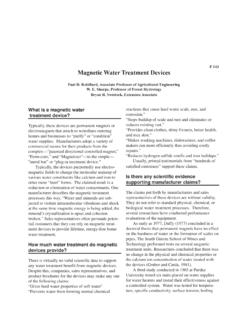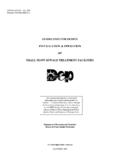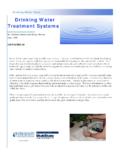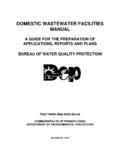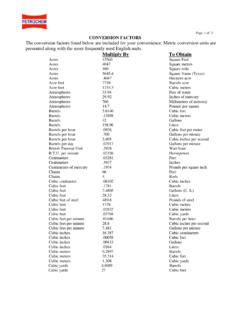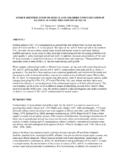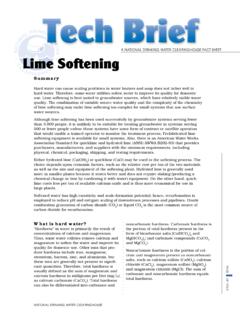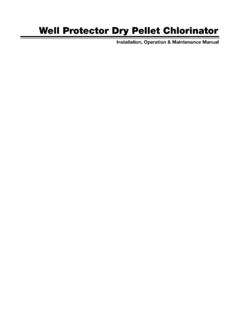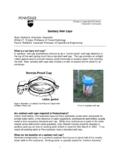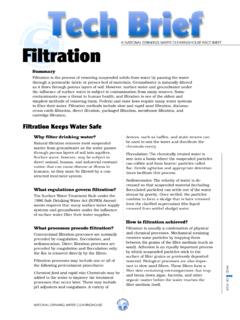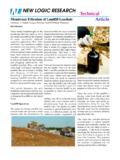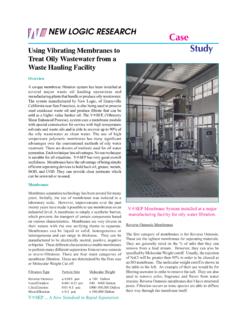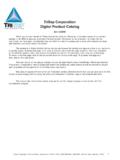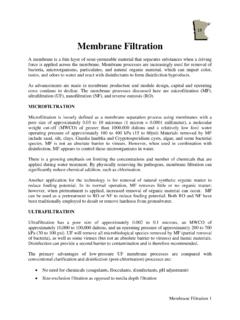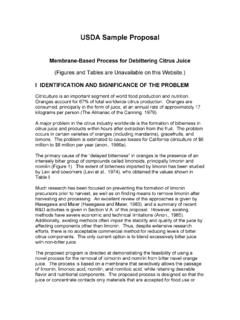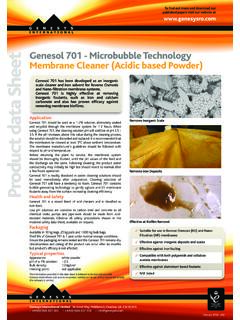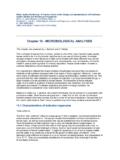Transcription of Coliforms: Membrane Filtration - Water Research
1 EPA Approved* Method 10029 Coliforms: Membrane Filtration (simultaneous detection) For detection of: total coliforms, E. coliMedia: m-ColiBlue24 BrothSample Type: potable Water , nonpotable Water , wastewaterSimultaneous Total coliform and E. coli ScreeningHach s new m-ColiBlue24 ** Broth allows for the simultaneous detection of total coliform bacteria and Escherichia coli (E. coli) within 24 hours. An enzymatic indicator in the medium causes non-fecal total coliform colonies grown on the m-ColiBlue24 medium to be red, while the E. coli (fecal coliform ) colonies are selectivity of the enzymatic indicator eliminates the need for confirmation.
2 The low false positive and false negative rates allow for the detection of at least 95% of all E. Broth enhances the growth rate of coliform bacteria and optimizes the recovery of stressed or injured organisms. Special inhibitors in the medium efficiently minimize the growth of non- coliform bacteria. Convenient PackagingHach s m-ColiBlue24 Broth comes in ready-to-use PourRite Ampules; no need to measure, mix, or autoclave. The ampules have a large, unrestrictive opening that allows the medium to pour easily. Simply break the top off the ampule, using the Hach ampule breaker, and pour the medium onto an absorbent pad in a petri ampule contains enough selective medium for one test.
3 Medium in PourRite ampules has a shelf life of one year. Ampules are shipped with a Certificate of Analysis and have an expiration date printed on the label. m-ColiBlue24 Broth is also available in plastic ampules and 100 mL : 24 hours at 35 CSensitivity: 1 CFU/100 mLSelectivity: Detects total coliforms and E. coliShelf Life: 1 year when refrigerated at 2 to 8 C and protected from lightTechnique is ImportantGood laboratory technique is essential when accuracy is important, particularly in microbiological laboratory procedures. Care in sample collection and preservation, a clean laboratory or work surface, proper sterilization and inoculation practices, and close temperature control help assure reliable results.
4 * This method is USEPA approved for drinking Water ** U. S. Patents 5,650,290 and 5,849,5152 Coliforms: Membrane Filtration (simultaneous detection), continuedPreparing MaterialsStart the incubator while preparing other materials. Adjust the incubator temperature setting to 35 Presterilized Equipment and MediaTo simplify techniques and minimize the possibility of contamination, use presterilized equipment and media. Hach offers presterilized and disposable Membrane filters, pipets, petri dishes, absorbent pads, inoculating loops, buffered dilution Water in 99-mL bottles, sampling bags, and prepared growth media.
5 MEL Portable Labs include presterilized consumables and field Filtration assembly. Using Field Filtration the top surface of the stainless steel Field Vacuum the syringe tip to the vacuum support : To sterilize forceps, dip forceps in alcohol and flame in an alcohol or Bunsen burner. Let forceps cool before sterile forceps, place a Membrane filter, grid side up, onto the center of the vacuum a package of funnels (start at the bottom of the package). Remove a funnel (base first) from the the funnel onto the vacuum support. Do not touch the inside of the funnel. Push evenly on the funnel s upper rim to snap it onto the vacuum the sample into the : See specific procedures for the sample volume on the syringe plunger to draw the sample through the filter the the lever on the vacuum support stem to lift the Membrane filter from the vacuum support sterile forceps to remove the Membrane the Membrane filter into a prepared petri dish and incubate according to the appropriate the syringe tip from the vacuum support tubing.
6 Dispose of the liquid in the steps 1 12 to filter remaining : Membrane Filtration (simultaneous detection), continued3 Using Autoclavable EquipmentWhen numerous samples must be run on a routine basis, you may prefer to use an autoclave for reusable sample bottles, pipets, petri dishes, filter holder with stopper, and graduated cylinder (if needed) with hot Water and several times with tap Water and then with deionized Water . Dry all equipment for autoclaving. Loosely thread caps on sample bottles and cover caps and bottle necks with metal foil or paper. Cover the openings of graduated cylinders with metal foil or paper.
7 Insert the filter funnel base into an autoclavable rubber stopper that will fit the filter flask. Wrap the two parts of the filter funnel assembly separately in heavy wrapping paper and seal with masking tape. Wrap petri dishes (borosilicate glass) in paper or place in aluminum or stainless equipment in an autoclave at 121 C for 15 minutes. Borosilicate glass items may be sterilized with dry heat at 170 C for a minimum of one Autoclavable Filter AssemblyDisinfect the work bench or work area with a germicidal cloth, dilute bleach solution, or dilute iodine solution. Wash hands thoroughly with soap and sterilization, remove the filter funnel assembly from the wrapping not contaminate the funnel by touching the inner surfaces that will be exposed to the the funnel with rubber stopper into the filtering flask or filter funnel manifold and connect to the Water trap and aspirator with rubber tubing.
8 Note: A vacuum pump may be used in place of the Water trap and aspirator. sterile forceps, place a sterile Membrane filter on the filter base and attach the filter funnel filtering the sample, filter a small quantity of sterile buffered dilution Water through the funnel to assure a good seal on the filter and : Membrane Filtration (simultaneous detection), continuedSample SizeSample size is governed by bacterial density and ideal sample volume of nonpotable Water or wastewater for coliform testing yields 20 80 coliform colonies per the coliform numbers are uncertain, three different volumes should be filtered and cultured.
9 Table 1 lists recommended volumes for samples from various the sample is less than 20 mL (diluted or undiluted), add 10 mL of sterile dilution Water to the filter funnel before applying the vacuum. This aids in distributing the bacteria evenly across the entire filter SamplesVery small sample volumes may be required for samples with large coliform populations or for very turbid samples. These volumes are obtained by making serial dilutions of the sample. One method of doing this is described a bottle of sterile Buffered Dilution the sample collection container vigorously, approximately 25 a sterile transfer pipet to pipet the required amount of sample into the sterile Buffered Dilution the buffered dilution Water bottle and shake vigorously 25 more dilutions are needed, repeat steps 3 5 using clean, sterile pipets and additional bottles of sterile Buffered Dilution SeriesA.
10 If a 10-mL sample is required: Transfer 11 mL of sample into 99 mL of sterile, buffered dilution Water . Filter 100 mL of this dilution to obtain the 10-mL If a 1-mL sample is required:Transfer 11 mL of the 10-mL dilution from step A into 99 mL of sterile dilution Water . Filter 100 mL of this dilution to obtain the 1-mL If a sample is required:Transfer 11 mL of the 1-mL dilution from step B into 99 mL of sterile dilution Water . Filter 100 mL of this dilution to obtain the If a sample is required:Transfer 11 mL of the dilution from step C into 99 mL of sterile dilution Water . Filter 100 mL of this dilution to obtain the If a sample is required:Transfer 11 mL of the dilution from step D into 99 mL of sterile dilution Water .
